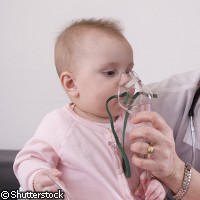Genetic variant and tobacco smoke exposure together increase risk for childhood asthma
Researchers in France have demonstrated that the association between asthma and genetic variants on chromosome 17q21 is restricted to early-onset asthma, and that the risk is further increased by early-life exposure to tobacco smoke. Their findings support the idea that early-onset and late-onset asthma are biologically different, making asthma not one disease but the manifestation of several different diseases. The study was funded in part under the EU's Sixth Framework Programme (FP6). Asthma is a chronic condition that affects the respiratory system, and is characterised by periodic episodes of airway constriction and inflammation: wheezing, shortness of breath, chest tightness and coughing ensue. The episodes may be triggered by any number of factors, including exposure to allergens, environmental tobacco smoke, exertion or emotional stress, to name a few. The causes of asthma are not completely understood, but it is clear that they involve a complex interaction of environmental and genetic factors. In the past few years increasing evidence has shown that genetic and environmental factors may only affect asthma when they are combined. Additionally, there is a growing consensus that asthma is not one disease but the clinical manifestation of various diseases. The study by Dr Emmanuelle Bouzigon of INSERM, France and colleagues, published this week in the journal Nature, tested variants of chromosome 17q21 in 1,511 subjects from 372 families and looked for associations with asthma, and more specifically with age of onset of asthma and exposure to environmental tobacco smoke early in life. The researchers demonstrated that the genetic variants were in fact associated with asthma, but only with asthma that began before subjects were four years old; no significant association was found between the variant and asthma when the onset was after age four. Furthermore, they found that the risk for asthma in the subjects with these variants was significantly increased by early-life exposure to environmental tobacco smoke. 'Under the best-fitting recessive model,' the study reports, 'the overall risk of early-onset asthma when smoking exposure was not taken into account was increased by a factor of 1.7 or more [...] whereas the risk was increased by a factor of 2.3 or more for [...] subjects with early-life exposure to environmental tobacco smoke.' Dr Bouzigon and colleagues conclude that their findings 'provide additional support that early-life events play a critical role in the pathogenesis of asthma,' and support the idea that asthma with an onset early in life differs biologically from asthma with a later onset. 'The data are consistent with the observation that since early-onset asthma and late-onset asthma have distinct genetic underpinnings, they are likely to result from distinct patho-biologic mechanisms,' they report. Dr John Holloway of Southampton University, UK and Dr Gerard Koppelman of the University of Groningen, the Netherlands, put the study's findings into context in an accompanying editorial. They acknowledge that the current study 'highlights the fact that asthma may be syndromic rather than a single disease entity'. They also caution that finding a strong association between a genetic variant and a disease adds much to our understanding of the functional role of the variants but that this 'lies far upstream (if it has any effect at all) of any effect on clinical practice'. One important question that further studies must seek to answer, according to Drs Holloway and Koppelman, is exactly how the alteration in the expression or function of the gene can lead to disease. The findings of Dr Bouzigon and colleagues provide a greater understanding of the role of 17q21 variants on the pathophysiology of asthma, but translating the findings into clinical practice is not a simple matter. There is still much to learn about the mechanisms by which this genetic variation increases susceptibility to asthma. The study was funded as part of the Global Allergy and Asthma European Network (GA2LEN) and the GABRIEL consortium under the Sixth Framework Programme (FP6).
Countries
France



